

How Structured Is Your Data? – Metaphorical Web – Medium. Programmers love a fight.

Ask a roomful of programmers the question “EMACS or VI”, leave the room for coffee, come back half an hour later and there will be blood on the floor. For data storage buffs, the same question, at least lately, comes down to SQL vs. NoSQL. Each has its defenders, its book of holy writ, its benchmarks and success stories … and each has its dark secrets and stunning failures as well. Yet the question of whether data content is SQL vs. JSON Schema Store. JSON Schemas are available for the following 106 files: Auto completion In supported JSON editors like Visual Studio and Visual Studio Code, schema files can offer auto-completion and validation to make sure your JSON document is correct.
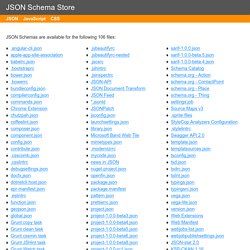
A Guide to JSON-LD for Beginners. A Complete Guide to JSON-LD - Search Engine Journal. When it comes to structured data, there are several formatting options out there (Microdata, RDFa, etc).
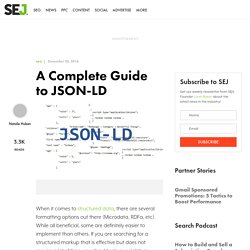
While all beneficial, some are definitely easier to implement than others. If you are searching for a structured markup that is effective but does not require a lot of time, you should set your sights on JSON-LD. And believe me, it’s not as complicated or confusing as most think it is, so turn any potential looks of extreme perplexity around before we dive in. Understanding JSON Schema — Understanding JSON Schema 1.0 documentation. JSON Schema is a powerful tool for validating the structure of JSON data.

However, learning to use it by reading its specification is like learning to drive a car by looking at its blueprints. You don’t need to know how an internal combustion engine fits together if all you want to do is pick up the groceries. This book, therefore, aims to be the friendly driving instructor for JSON Schema. Difference between Json, XML and RDF. JSONLint - The JSON Validator. JSON Schema Validator - Newtonsoft. JSON Formatter & Validator. JSONLint - JSON Validator. OCLC Developer Network. JSON Guide and Examples. JSON Schema. JSON Schema is a specification for JSON based format for defining the structure of JSON data.
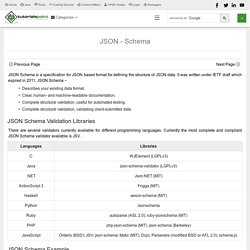
It was written under IETF draft which expired in 2011. JSON Schema − Describes your existing data format.Clear, human- and machine-readable documentation.Complete structural validation, useful for automated testing.Complete structural validation, validating client-submitted data. JSON Schema Validation Libraries There are several validators currently available for different programming languages. JSON extraction using JSONPath - SOASTA Community. CloudTest provides support for extracting values from JSON document responses using JSONPath.

JSONPath UI options are found in the Message Editor, in the Session Template Package Wizards's Clip Scanner, or while using the Session Template Wizard. Additionally, scripts can use two new JSONPath Message properties via the getResponse method: RESPONSE_HTTP_BODY_WITH_JSONPATH and RESPONSE_TEXT_WITH_JSONPATH. Support using JSONPath resolves limitations imposed by XML that are not limitations of JSON itself including use of whitespace, special characters, and numbers. Since JSONPath is designed for JSON, and not XML, CloudTest is capable of producing much better extractions using JSONPath. TIP: Users new to JSONPath may wish to refer to the following resources: The examples in this article uses the following JSON document example as response text.
What is JSON? JSON is a human-readable text format that facilitates data interchange between different programming languages.
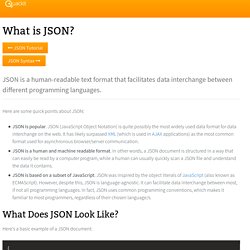
Here are some quick points about JSON: JSON is popular. JSON (JavaScript Object Notation) is quite possibly the most widely used data format for data interchange on the web. It has likely surpassed XML (which is used in AJAX applications) as the most common format used for asynchronous browser/server communication. JSON-LD is a notation for structured data representation that adheres to Linked Data principles… JSON-LD 1.0. 5.

Basic Concepts. JSON vs XML: How JSON Is Superior To XML. Steal Our JSON-LD – Structured Data. Made Simple. Structured Data Markup Formats: Microdata vs JSON-LD vs RDFa. Do you want your web pages to stand out in search results?
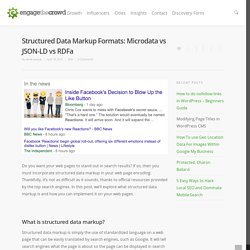
If so, then you must incorporate structured data markup in your web page encoding. Thankfully, it’s not as difficult as it sounds, thanks to official resources provided by the top search engines. In this post, we’ll explore what structured data markup is and how you can implement it on your web pages. Structured data markup is simply the use of standardized language on a web page that can be easily translated by search engines, such as Google. It will tell search engines what the page is about so the page can be displayed in search results with rich snippets of content. JSON-LD in Real Life: Understanding and Implementing Structured Data. Chances are, you’ve already heard of JSON-LD — you might even be using it already.
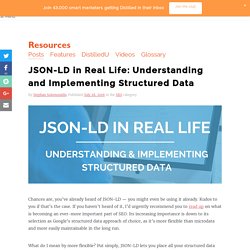
Kudos to you if that’s the case. If you haven’t heard of it, I’d urgently recommend you to read up on what is becoming an ever-more important part of SEO. Its increasing importance is down to its selection as Google’s structured data approach of choice, as it’s more flexible than microdata and more easily maintainable in the long run. What do I mean by more flexible? Put simply, JSON-LD lets you place all your structured data between a special pair of <script> tags in the <head> of the HTML, much as you would with Google Analytics tracking snippets or canonical tags. <head>... JSON Structures. JSON: What It Is, How It Works, & How to Use It - Copter Labs.
This week I want to cover a topic that I feel has become an important part of any developer’s toolkit: the ability to load and manipulate JSON feeds from other sites via AJAX. Many sites are sharing data using JSON in addition to RSS feeds nowadays, and with good reason: JSON feeds can be loaded asynchronously much more easily than XML/RSS. This article will cover the following: Untitled. Introduction to Structured Data Google Search works hard to understand the content of a page. You can help us by providing explicit clues about the meaning of a page to Google by including structured data on the page.
Structured data is a standardized format for providing information about a page and classifying the page content; for example, on a recipe page, what are the ingredients, the cooking time and temperature, the calories, and so on. Google uses structured data that it finds on the web to understand the content of the page, as well as to gather information about the web and the world in general. JSONLint - The JSON Validator.
About JSONLint? JSONLint is a validator and reformatter for JSON, a lightweight data-interchange format. Copy and paste, directly type, or input a URL in the editor above and let JSONLint tidy and validate your messy JSON code. Tips & Tricks You can directly input a URL into the editor and JSONLint will scrape it for JSON and parse it. Home - Online JSON Query Tester. Introduction to JsonPath. 1. Overview One of advantages of XML is the availability of processing – including XPath – which is defined as a W3C standard. For JSON, a similar tool called JSONPath has emerged. This article will give an introduction to Jayway JsonPath, a Java implementation of the JSONPath specification.
It describes setup, syntax, common APIs, and a demonstration of use cases. 2. In order to use JsonPath, we simply need to include a dependency in the Maven pom: 3. The following JSON structure will be used in this section to demonstrate the syntax and APIs of JsonPath: 3.1. JSONPath Expression Tester. Jsonpath online evaluator. XML vs. JSON - A Primer. As more and more Web and mobile applications utilize APIs to drive their respective front ends, performance becomes an emerging concern. XML, long used as a method for exchanging data, is giving way to JSON, now considered the gold standard. But is JSON always the right choice over XML? As an API designer, it’s important to understand the foundations of JSON and XML, as well as the differences between them.
XML: ‘Data stuffed’ XML, or Extensible Markup Language, is the functional cousin to HTML. Responses were invariably structured as XML. With all of that said, XML can hold any data type imaginable, in an easy-to-read format. <? It doesn’t take much to deduce that this piece of code represents a medical document of some sort. What is JSON?: An Introductory Guide. Some days it’s hard to remember if Moore’s law applies to increasing computer power or the number of technologies and breadth of terminology impacting our daily work.
What is JSON: the 3 minute JSON Tutorial (secretGeek.net) [code], css, functional, html, javascript, linguistics, microISV, nimbletext, sql, tools, visual basic, working blue If you are anything like me (and I fear that you are) then this is your experience with JSON so far: Two months ago you'd never heard of JSONOne month ago you'd heard the term but paid no attentionOne week ago you'd heard it mentioned a few times and started to think, right... some more crap to learnToday you woke up with an alarm bell ringing in the back of your mind that said WHAT THE BLOODY HELL IS THIS JSON THING AND WHY IS IT EVERYWHERE ALL OF A BLOODY SUDDEN! Well I had a slow bus ride home tonight (friday is always slow) and i took a pile of "JSON" tutorials with me. JSON Basics: What You Need to Know. Tutorial by Matt Doyle | Level: Intermediate | Published on 24 March 2011.
JSON Schema. JSON. JSON Schema Toolset, SDK and Documentation. Understanding JSON Schema — Understanding JSON Schema 1.0 documentation. JSON Schema. JSON Formatter & Validator. JSONLint - The JSON Validator. JSON Syntax. JSON Editor Online - view, edit and format JSON online. JSON Basics: What You Need to Know. An Introduction to JavaScript Object Notation (JSON) in JavaScript and .NET.